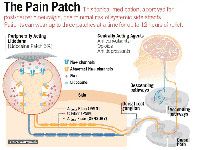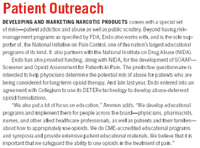Feeling No Pain
Pharmaceutical Executive
Lifecycle management and line extensions helped the Percocet franchise generate steady annual growth, rising from $40 million in 1997 sales to $214 million in 2003, despite the fact that it had no patent protection.
Our goal when we started this company was to reach the point that when people think about pain management, they think of Endo," says CEO Carol Ammon.

Carol Ammon, CEO of Endo Pharmaceuticals, received the 2003 Greater Philadelphia Ernst & Young Entrepreneur of the Year Award.
If the company is not quite there, it should be very soon. Last year, Pennsylvania-based Endo Pharmaceuticals, maker of both brands and generics, experienced a 49 percent growth in sales—from $399 million to $596 million. Much of that jump came from Lidoderm, a lidocaine patch whose sales more than doubled and which analysts see as the company's most significant future growth driver. The product is indicated for post-herpetic neuralgia (neuropathic pain), a rapidly growing market in which Endo already has a 26 percent share. With two new launches and three products under FDA review, the company is also poised to grab a big piece of the chronic pain market. The greatest gains will come from Endo's:
- generic versions of extended-release oxycodone, which will cut into Purdue's $1.9 billion in annual revenue from OxyContin
- generic fentanyl patch, which will grab some of J&J's $1.3 billion in sales for Duragesic.
But Endo isn't relying only on short-term gains from generic copies of blockbusters. It also has a deep pipeline of patent-protected, in-licensed products and development deals that are setting it up for long-term stability in a global pain-management market that's expected to expand greatly as the population ages.
Mentality Shift
Most of those aging consumers will be US baby boomers, who are much less inclined than their Depression-era parents to be stoics about pain. "In the old school thinking, patients wanted to please their physicians," Ammon says. "They were willing to say they were okay when they were not." In the last ten years, there has been a vast change in that attitude, much of it a result of patient education—through the internet, direct-to-consumer advertising, and outreach efforts from patient groups and companies like Endo.

Topical lidocaineâÂÂs mechanism of action is to stabilize neuronal activity linked with Na+ channel accumulation, which reduces pain signal initiation and transmission. The patch acts locally on damaged peripheral nerve and soft tissue, but does not cause complete sensory block in the area of application.
"We are not yet where we need to be, but there is a much better understanding of the need to aggressively treat pain," Ammon says. "There is now a whole specialty in the area of pain management, which was added in the early 1990s. Physicians have the opportunity to take their residency in pain management. And in the past, hospitals were never assessed on how well they were treating pain. Now all the new accreditation standards rate hospitals on how effectively they are assessing and treating pain. Every patient visit now must be accompanied by an assessment of the patient's pain. Patients are asked how they feel, on a scale of zero to ten. That has to be monitored and logged in their patient forms."
This shift in the mentality of treating pain has driven the market into new territory, both in terms of revenue and products. According to Visiongain, the global pain-management market is expected to grow at an annual rate of 4.7 percent and will hit $29.7 billion in 2007. Patient convenience and compliance are also driving technology-based pharmas to develop novel delivery mechanisms. In fact, most of the compounds prescribed to treat pain have been around for decades, and the competitive edge in this market goes to companies that find novel formulations that are easy for patients to use.
Full Circle
Endo, as a name in pharmaceuticals, has been around a long time, too. The company was founded in 1920 in New York as a family-run business. DuPont, whose pharma unit was primarily focused on pain management, bought Endo in 1969 and retired the name. Ammon, with degrees in biology and business, joined DuPont in 1973. Over the next two decades, she worked with and promoted the products that had come from Endo.

Patient Outreach
But in the late 1980s and early 1990s, DuPont started to move into the cardiovascular therapeutic category and the AIDS market. Then in 1994, Dupont and Merck entered into a joint venture, and Endo Laboratories re-emerged as their generics division. It was short lived. In 1997, the joint venture took a hard look at the generics division and some nonpromoted brand-name products such as Percocet (oxycodone/acetaminophen), and decided to sell.
"They decided to retire the pain-management franchise," recalls Ammon, who by that time was president of Dupont/Merck's US pharmaceutical business. Citing her "passion around pain management," Ammon decided to buy those products. Along with her coworker and cofounder, Mariann MacDonald, Ammon raised the $277 million needed to buy about 35 drugs (generics and brands) and launch an independent company.
"When I saw the opportunity to buy these assets and the fact that most of them were in the area of pain management, the light bulb went off for me," Ammon says. "At that time, it was an underserved area. It certainly was not an area for Big Pharma any more, because it was not as big as some of those other therapeutic categories. DuPont did the right thing in pursuing cardiovascular and AIDS, but I saw an opportunity to follow my dream in terms of developing this area of pain management. Essentially, I have been doing the same thing and been involved in the same products for 31 years."
Ammon and MacDonald revived the Endo name because of its brand equity. "Customers had a lot of respect for the original Endo company," Ammon says. In 2000, the new Endo acquired Algos (a drug development company in Neptune, New Jersey) and began trading on the NASDAQ exchange.
After spending her entire career at one company, Ammon says what gave her the courage to step out on her own was a sabbatical she took in 1995. "DuPont sent me to the Advanced Management Program at Harvard," she recalls. "It was an opportunity to learn a lot about myself. When I came back from the program, I felt very confident about my desire to lead an organization."
Lifecycle Management
The Endo name was not all that Ammon revived. The company's flagship product Percocet—an analgesic that had entered the market in 1976 and quickly became the standard of care in treating acute pain—was off patent and facing generic competition. The good news was that over the years, despite new entries and, eventually, generic competition, Percocet retained its brand equity.
"Even though it has had generic competition since the mid-1980s, more than 80 percent of the prescriptions [for oxycodone/acetaminophen] are still written as Percocet, as opposed to the generic name," Ammon says. What the company needed was to find a way to expand brand usage. The solution was new formulations.
"When we went back and looked at how Percocet was prescribed, we saw that physicians were prescribing it in such a manner that suggested they were looking for higher doses," Ammon says. "So we felt that if we could work with FDA to allow us to submit an application for higher doses, we would be successful in lifecycle management and some line extensions. And that is precisely what we did. We filed new applications for higher doses of Percocet. We got those approved, and we were successful in getting greater brand dispensing."
From 1997 to 2003, the Percocet franchise enjoyed steady annual growth, rising from $40 million in sales to $214 million, despite the fact that it had no patent protection. But generic competition in 2004 led to a decline in the product's sales. "They've had a difficult 2004," says one analyst. "But what they've done during the year has strengthened the outlook for 2005, and the negatives of 2004 won't apply." In fact, Endo's lull this year will be fully compensated by next year's busy schedule.
Launch Year
In fact, Endo sales reps should have their bags full of new products by the end of 2005. The first new product is Frova (frovatriptan), a treatment that has been marketed in the United States since mid-2002 for acute migraine in adults. It was launched by Endo this September after the company acquired the North American marketing rights from UK-based Vernalis. The second new product, DepoDur, is launching now. The sustained-release morphine injection, which was licensed by Endo for North American distribution in late 2002, was developed by London-based SkyePharma and approved by FDA this past May for pain following major surgery."
"SkyePharma is currently validating and preparing launch quantities," Ammon says. "But we just kicked off a dedicated hospital force. We started with 25 reps and will add another 45 after the first of the year when we commercialize the product. We are now in the hospital with these reps, building advocacy, teaching anesthesiologists how to use the product, and working with pharmacists to understand what the product is about and to get it onto formulary. We will begin shipping by the end of this year."
For abdominal surgeries, C-sections, and hip and knee replacements, anesthesiologists can now inject DepoDur into the epidural space (before or during the surgery) and give their patients 48 hours of postsurgical pain relief. Ammon believes the product has the potential to change the standard of post-surgical care. Some analysts concur with that potential but believe it will take some time for physicians to "get comfortable" with long-acting morphine.
Oxymorphone. Presently under FDA review, this product is one that "we are very excited about," says Ammon. The compound was originally developed in the 1960s but never really received much attention as other opioids came on the market. Now Endo, in a co-development deal with Penwest, has reformulated the product as an extended-release tablet for patients who need around-the-clock pain relief for extended periods of time. Endo has also developed an immediate-release tablet for acute pain.
"Because we already have an injection and suppository on the market [Numorphan], this will be the only controlled-release, oral opioid with four different formulations—injection, suppository, oral-controlled release, and an immediate release for breakthrough pain," says Ammon. "What's nice about that is that patients can be started in the hospital environment on the injection and can be sent home to use the controlled release. And in end-of-life situations, a suppository can be used. We feel it's going to be a very useful product in terms of all the different patient needs."
FDA issued Endo an approvable letter last October and then asked the company to do another study. Two of the Phase III studies had been done with opioid-naive patients, and there was a significant number of dropouts because of side effects, which is common with opioids. Endo has met with FDA about the design of a new study, and it expects to begin the trial soon.
Extended-release oxycodone. This generic version of Purdue's OxyContin received FDA's green light in March, but Endo is waiting for a final court ruling before it launches the product.
"We were the first to file on the 10-, 20-, and 40-mg strengths of OxyContin, which we were very pleased about," Ammon says. "If we choose to wait for the appeal, the exclusivity stays with us. After looking at several different factors, we decided to wait for the appeal. We are confident about our case, and if that appeal is ruled in our favor, then our exclusivity kicks in that day and we'll launch immediately after."
(The hearing was scheduled for November 3, after this story went to press. The final decision in the case is not expected for another three to six months after that.)
Fentanyl patch. The abbreviated new drug application (ANDA) for a generic version of Johnson & Johnson's Duragesic—the most frequently prescribed product for cancer pain—was submitted by Endo's development partner, Novena Pharmaceuticals, in July 2003. Analysts expect this drug to be Endo's greatest source of new revenue (up to $150 million a year), even though it will have multiple competitors.
Ammon describes her strategy: "We entered into a relationship with Novena to be able to be market its AB-rated generic equivalent of Duragesic. We are waiting for approval of that product, and we hope to be in the market at the same time as anybody that gets there in January 2005. It competes in that strong opioid market."
More to Come
In addition to the products that are now under FDA review, Endo also has pipeline projects and licensing deals that will not only expand its pain-management franchise but will also permit Endo to enter complementary therapeutic areas such as neurology, peri-operative care, and supportive-care oncology. One late-stage product is propofol, an anesthesia licensed from SkyePharma. And in Phase II is a development project with Durect that is intended for patients with chronic pain.
"Chronogesic (sufentanil) is a very strong opioid, contained in a small, implantable pump about the size of a matchstick," Ammon explains. "It is implanted in the subcutaneous tissue of the arm in a very quick procedure—a couple of minutes in a doctor's office. Over a course of three months, it is intended to deliver relief for chronic pain."
In another Phase II development, the company is testing its Lidoderm patch in patients with both acute and chronic lower-back pain. The market for this indication could be substantial, because low-back pain is the most common chronic pain condition, affecting an estimated 36 million Americans. Endo is also evaluating another licensed product, LidoPAIN BP from EpiCept, for acute low-back pain. And in very early stages is a deal with MakScientific to develop cannabinoids, a promising new way to treat pain. Several other companies are working on cannabis-based drugs, and the future market for these products could be very competitive.
Endo also recently signed two new licensing agreements. One is with Swedish Orexo AB to develop and market Rapinyl, an oral, fast-dissolving fentanyl tablet for breakthrough cancer pain. The other deal (previously mentioned), in which it licensed marketing rights to Frova, is projected to generate $50 million in sales next year.
"What we saw in Frova was that it seems to be differentiated from all the other triptans in that is has a very long half-life—26 hours," Ammon explains. "The next longest half-life of any of the products out there is four or five hours. The other interesting piece about this product is that Vernalis had completed a successful Phase III study looking at a potential indication in prophylaxis for menstrually associated migraines. If you look at the migraine market, about 70 percent of the sufferers are women. And the majority of their migraines seem to be of greater intensity and greater occurrence during the menstrual cycle." Endo hopes to file a supplemental new drug application for that indication in the first half of 2006.
Growth Strategy
Because the basic compounds used to treat pain are mostly off patent, this market is particularly competitive, and the distinction between brands and generics is a little blurry. Endo, which has both brands and generics and an aggressive in-licensing strategy, seems geared to be a strong competitor. "Now is the time investors should be revisiting the stock," says one analyst. "As we move into 2005 it becomes far more interesting." And C.E. Unterberg, Towbin rates Endo a "buy," even if it loses its court case involving the generic version of Purdue's OxyContin.
"Essentially we are looking for growth opportunities," Ammon says. "We could in-license products that basically give us cash flow but do not have opportunities for further development. But we are really looking for products that will meet unmet medical needs and will allow us to invest in and grow the products. The other factor is that we are looking to stay focused. We started out with a mission to be totally in pain management. Now we want to expand that focus—not broadly, but a little bit—to be in some of the near-pain areas. CNS [central nervous system] and migraine are a perfect example of that. And we are launching DepoDur, which gave us an opportunity to move into peri-operative care. So we are in that postsurgical, hospital environment; but we are still in pain."
In the pain market that is. As a business, Endo is feeling quite well.
Addressing Disparities in Psoriasis Trials: Takeda's Strategies for Inclusivity in Clinical Research
April 14th 2025LaShell Robinson, Head of Global Feasibility and Trial Equity at Takeda, speaks about the company's strategies to engage patients in underrepresented populations in its phase III psoriasis trials.
Beyond the Prescription: Pharma's Role in Digital Health Conversations
April 1st 2025Join us for an insightful conversation with Jennifer Harakal, Head of Regulatory Affairs at Canopy Life Sciences, as we unpack the evolving intersection of social media and healthcare decisions. Discover how pharmaceutical companies can navigate regulatory challenges while meaningfully engaging with consumers in digital spaces. Jennifer shares expert strategies for responsible marketing, working with influencers, and creating educational content that bridges the gap between patients and healthcare providers. A must-listen for pharma marketers looking to build trust and compliance in today's social media landscape.
